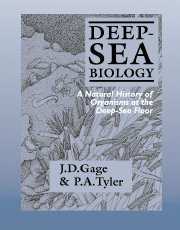Book contents
- Frontmatter
- Contents
- Preface
- Acknowledgements
- PART I The development of deep-sea biology, the physical environment and methods of study
- PART II Organisms of the deep-sea benthic boundary
- PART III Patterns in space
- 6 Small-scale spatial patterns
- 7 Abundance and size structure of the deep-sea benthos
- 8 The diversity gradient
- 9 Depth-related patterns in community composition
- 10 Zoogeography, speciation and the origin of the deep-sea fauna
- PART IV Processes: patterns in time
- PART V Parallel systems and anthropogenic effects
- References
- Species index
- Subject index
7 - Abundance and size structure of the deep-sea benthos
Published online by Cambridge University Press: 05 June 2012
- Frontmatter
- Contents
- Preface
- Acknowledgements
- PART I The development of deep-sea biology, the physical environment and methods of study
- PART II Organisms of the deep-sea benthic boundary
- PART III Patterns in space
- 6 Small-scale spatial patterns
- 7 Abundance and size structure of the deep-sea benthos
- 8 The diversity gradient
- 9 Depth-related patterns in community composition
- 10 Zoogeography, speciation and the origin of the deep-sea fauna
- PART IV Processes: patterns in time
- PART V Parallel systems and anthropogenic effects
- References
- Species index
- Subject index
Summary
There are two major variables that are clearly related to resource availability in the deep-sea environment. First, the density (standing crop), expressed either as biomass, organic or carbon content, or numbers of individuals; and second the body size of individuals. With both, a large literature has demonstrated, or qualified, an inverse relationship to bathymetry along the depth gradient from the continental shelf to the abyss.
DENSITY
In this chapter we shall concentrate on quantitative investigations of the abundance of benthic life on and within the deep-sea bottom. This is because quantitative data on the purely benthopelagic fauna are very sparse. However, there are indications that biomass of gelatinous organisms, such as sea cucumbers, found swimming just off the bottom may, in places, be high (Childress et al., 1989). We shall consider biomass of other benthopelagic organisms, such as large, swimming scavenging organisms, along with other megafauna later in the chapter.
Quantitative studies of the deep-sea benthos date from the 1950s with the cruise of the ‘Galathea’. On this voyage a 0.2 m2 Petersen grab was first used in the deep sea (Spärck, 1956b) and this followed upon many Russian deep-sea expeditions using the 0.25 m2 ‘Okean’ grab (Filatova, 1982). The Russian studies have underlined the positive relationship between pelagic and benthic productivity, and their results (Fig. 7.1) largely reinforce the general prediction that density of benthic life decreases with depth and distance from shore, as well as from polar and temperate to tropical latitudes (Filatova, 1982).
- Type
- Chapter
- Information
- Deep-Sea BiologyA Natural History of Organisms at the Deep-Sea Floor, pp. 181 - 200Publisher: Cambridge University PressPrint publication year: 1991
- 1
- Cited by

